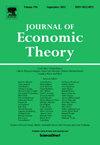犯罪网络的动态分析
IF 1.2
3区 经济学
Q3 ECONOMICS
引用次数: 0
摘要
我们采用一种基于微分对策的新方法来研究犯罪网络。我们将静态犯罪网络游戏(Ballester et al., 2006,2010)扩展到一个动态环境中,即犯罪活动对经济中总财富的积累产生负面影响。我们推导了一个马尔可夫反馈均衡,并表明,与静态犯罪网络博弈不同,均衡犯罪率向量不一定与Bonacich中心性向量成正比。接下来,我们对网络规模、网络密度和边际期望惩罚进行了比较动态分析,结果与静态犯罪网络博弈的结果形成了对比。我们还揭示了网络理论文献中的一个新问题,即贪婪效应的存在。最后,我们研究了当规划者的目标是使每个时间点的总犯罪最小时,在罪犯群体中确定最优目标的问题。我们的分析表明,动态和静态环境中的关键角色可能不同,动态环境中的关键角色可能随着时间的推移而改变。本文章由计算机程序翻译,如有差异,请以英文原文为准。
A dynamic analysis of criminal networks
We take a novel approach based on differential games to the study of criminal networks. We extend the static crime network game (Ballester et al., 2006, 2010) to a dynamic setting where criminal activities negatively impact the accumulation of total wealth in the economy. We derive a Markov Feedback Equilibrium and show that, unlike in the static crime network game, the vector of equilibrium crime rates is not necessarily proportional to the vector of Bonacich centralities. Next, we conduct a comparative dynamic analysis with respect to the network size, the network density, and the marginal expected punishment, finding results in contrast with those arising in the static crime network game. We also shed light on a novel issue in the network theory literature, i.e., the existence of a voracity effect. Finally, we study the problem of identifying the optimal target in the population of criminals when the planner's objective is to minimize aggregate crime at each point in time. Our analysis shows that the key player in the dynamic and the static setting may differ, and that the key player in the dynamic setting may change over time.
求助全文
通过发布文献求助,成功后即可免费获取论文全文。
去求助
来源期刊

Journal of Economic Theory
ECONOMICS-
CiteScore
2.50
自引率
12.50%
发文量
135
期刊介绍:
The Journal of Economic Theory publishes original research on economic theory and emphasizes the theoretical analysis of economic models, including the study of related mathematical techniques. JET is the leading journal in economic theory. It is also one of nine core journals in all of economics. Among these journals, the Journal of Economic Theory ranks fourth in impact-adjusted citations.
 求助内容:
求助内容: 应助结果提醒方式:
应助结果提醒方式:


